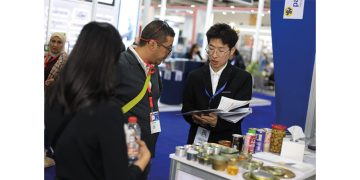Özsarı Gıda is one of the prominent names in Turkish bulgur sector.
We asked Ayvaz Sarı, member of board, the success story of the firm:
Would you please tell us the history of the firm in brief?
Our company was founded in the year 1978, with 1.000m2 closed and 5.000m2 open manufacturing facilities, with a daily production capacity of 3 tons of bulgur (boiled and pounded wheat) . In time, via the new investment and increase of capacity, Özsarı bulgur has been a prominent firm in the bulgur sector in Turkey and worldwide , with 15.000m2 closed and 30.000 m2 open, with a total of 45.000m2 manufacturing facilities, 240 tone/daily production capacity with its own production technology.
Which products constitute your range of products?
Packaging and marketing of bulgur like Coarse bulgur, Fine bulgur, Brown fine bulgur, vermicelli bulgur, a total of 12 different bulgur such as cerish, red lentils, chick peas, beans etc. and spices like peppermint, sumac, chili pepper.
What is the market position of your products? What is your expectation of these products? What is the position of Turkish bulgur production in the world?
Our country has the most developed bulgur industry, technology and capacity compared to world countries. In terms of wheat used in production and machinery, we manufacture with % 100 domestic industries, % 100 domestic raw materials. In our country,after bread, bulgur is a nutritious staple food which has an important place in people’s daily diets especially in the country side. Previously, bulgur was produced for the needs of families by conventional methods in small scale; in time it has developed and presently it has become a branch of industry. Bulgur is a staple food which is cheap, durable, of high nutritional value and easy to prepare, consumed in abundance not only in our country but also in Europe, America, and in other many countries.
Would you please give information about the quality and capacity?
Özsarı, being one of the first bulgur facilities that changed to using closed-circuit drying system in 1997; again is one of the first bulgur facilities that has obtained ISO9001 and ISO22000 certificates in the year of 2002. It pioneered the bulgur sector in production technology with the addition of Sortex-Color sorting machine to machinery in 2004. At first production capacity was 120 tons/daily in the years 2008- 2009 and lastly it became 240 tons/daily via the investments made.
Would you please give information about your exportation? Which countries do you export to?
It has begun to package legumes as well as bulgur with the built packaging plant in 2007, after 2008, our products have gained access to overseas markets as a result of our export oriented endeavors. As of today, a total of 20% of our own brand as well as Private Label brand is being exported to 17 countries ranging from America to Australia.
Are there any problems in the sector and do you have any solutions to offer?
Unfortunately, due to insufficient publicity, there are people even in our country who do not know about bulgur, there are even people who have not even tasted it. At the present time, many of facilities are operating with the marginal capacity. In the last years, it was determined that the demand from both domestic and abroad has increased due to organization of events and promotion work conducted by MBTG (macaroni, bulgur, legumes and vegetable oil promotion group).
Is there anything else you would like to especially add?
Wheat is composed the sections: substance, bran and endosperm. Essential nutrients are in substance and bran sections (Minerals such as Zinc, magnesium, chrome, dietary fiber, some phenols, phytates and selenium; moreover all vitamin B2s excluding vitamin B-12. Bulgur is a food that is known for its rich bagasse/crude fiber and for reducing hyperlipidemia in blood. Bulgur is richer in protein and poorer in carbohydrates. B1 vitamin content in bulgur plays an important role in the nervous and digestive systems. Due to folic acid content in bulgur, it is a very important nutrient for children and pregnant women; because the unsaturated fat and total fat ratio is low it is a healthy food. Bulgur does not contain cholesterol, due to the reason that bulgur undergoes through cooking and drying processes, it does not incorporate phytic acid which is the biggest disadvantage for cereals. Bulgur, accelerates food absorption due to the high content of minerals and cellulose, it impedes constipation and prevents the onset of bowel cancer. When cooked together with legumes, bulgur becomes one of the most important food sources in the world; it is also durable against radiation. The nutrient value of bulgur is greater than that of bread and pasta; it is durable against molding due to the cooking-drying processes. The fiber content gives a sensation of fullness; this feature plays an important role in weight control. We can easily get full by consuming one plate of bulgur. Due to its low glycemic index it makes you feel full for a long time, and because it mixes in the blood slowly, people may use it during dieting. Bulgur is more nutritive than rice and couscous, it is recommended as an alternative food for diabetics.















